
Acanthaceae is a family of dicotyledonous flowering plants containing almost 250 genera and about 2500 species. Most are tropical herbs, shrubs, or twining vines; some are epiphytes. Only a few species are distributed in temperate regions. The four main centres of distribution are Indonesia and Malaysia, Africa, Brazil, and Central America. Representatives of the family can be found in nearly every habitat, including dense or open forests, scrublands, wet fields and valleys, sea coast and marine areas, swamps, and mangrove forests.
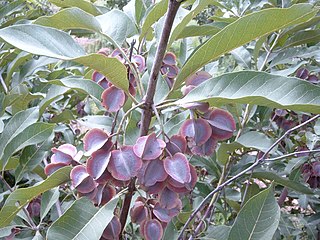
Combretum, the bushwillows or combretums, make up the type genus of the family Combretaceae. The genus comprises about 272 species of trees and shrubs, most of which are native to tropical and southern Africa, about 5 to Madagascar, but there are others that are native to tropical Asia, New Guinea and the Bismarck Archipelago, Australia, and tropical America. Though somewhat reminiscent of willows (Salix) in their habitus, they are not particularly close relatives of these.

Myrica is a genus of about 35–50 species of small trees and shrubs in the family Myricaceae, order Fagales. The genus has a wide distribution, including Africa, Asia, Europe, North America and South America, and missing only from Australia. Some botanists split the genus into two genera on the basis of the catkin and fruit structure, restricting Myrica to a few species, and treating the others in Morella.

Cissus is a genus of approximately 350 species of lianas in the grape family (Vitaceae). They have a cosmopolitan distribution, though the majority are to be found in the tropics.

Cyphostemma is a flowering plant genus in the family Vitaceae, with around 250 species distributed throughout the tropics and subtropics. These species are caudiciform and used to belong to the genus Cissus. The genus name comes from Greek kyphos, meaning hump, and stemma, meaning garland.
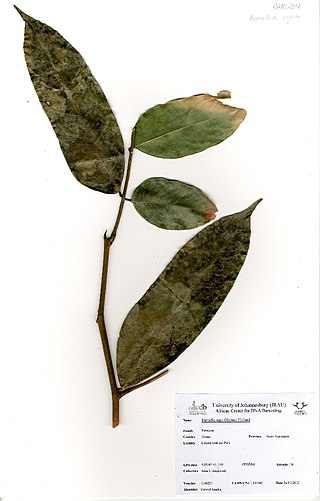
Daniellia is a genus of plants in the family Fabaceae, named after William Freeman Daniell. It includes ten species native to sub-Saharan Africa, ranging from Senegal to Sudan and south to Zambia and Angola.

Gilbertiodendron is a genus of legume in the family Fabaceae. It consists of about 25 species of tree native to west and west-central tropical Africa. Members of this genus were formerly considered to be in the genus Macrolobium but that genus is now restricted to species growing in tropical America. It is closely related to Pellegriniodendron.

Hymenostegia is a genus of flowering plants in the family Fabaceae. It includes 14 species native to west and west-central tropical Africa.
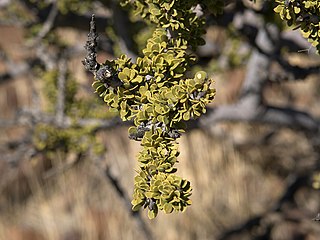
Boscia is a genus of plants in the family Capparaceae. It contains the following species:
Soyauxia is a genus of flowering plants in the family Peridiscaceae. They are small trees or erect shrubs from wet forests of tropical West Africa. Eight specific names have been published in Soyauxia. Additional species have been discovered, but their names and descriptions will not be published until 2009 or 2010. The type species for the genus is Soyauxia gabonensis.
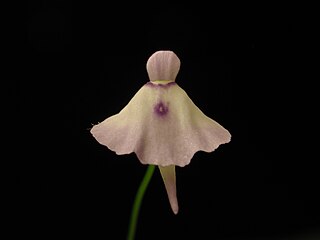
Utricularia pubescens is a small to medium-sized, probably annual, terrestrial or lithophytic carnivorous plant that belongs to the genus Utricularia and is the only member of Utricularia sect. Lloydia. U. pubescens is native to India, tropical Africa, and Central and South America. It was originally published and described by James Edward Smith in 1819 and placed in its own section, Lloydia, by Peter Taylor in 1986. It grows as a terrestrial or lithophytic plant in boggy grasslands in damp peaty soils at altitudes from sea level to 1,900 m (6,234 ft). This species possesses small peltate leaves, which are diagnostic for this species in the genus.

Dissotis is a genus of plants in the family Melastomataceae. There are about 49 accepted species, which are distributed across most of Africa, except Northern Africa.
Paxia is a genus of plants in the family Connaraceae, first described in 1891. It is native to west-central Africa.
Calvoa is a genus of flowering plants belonging to the family Melastomataceae.

Chytranthus is a genus of flowering plants belonging to the family Sapindaceae.
Cincinnobotrys is a genus of flowering plants belonging to the family Melastomataceae.
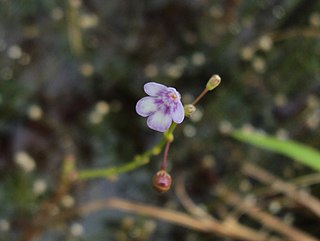
Dopatrium is a genus of flowering plants belonging to the family Plantaginaceae.
Pancovia is a genus of flowering plants belonging to the family Sapindaceae.
Scytopetalum is a genus of flowering plants belonging to the family Lecythidaceae.













